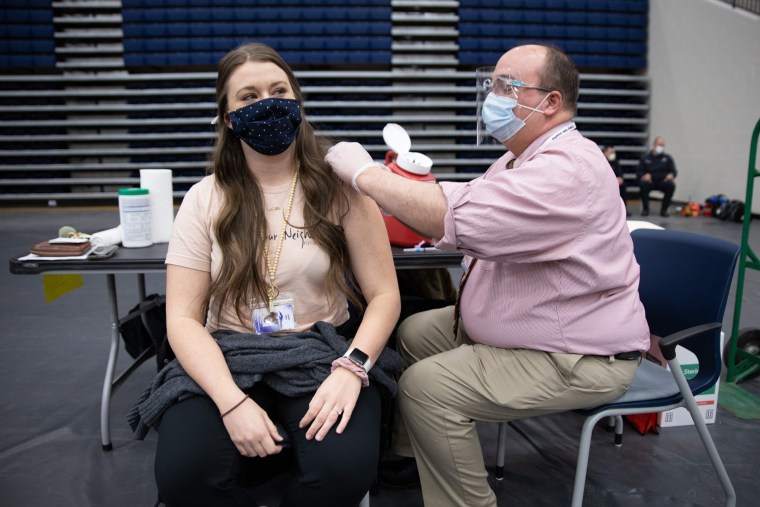COLUMBUS, Ohio — Ohio, the state that launched the national movement to offer millions of dollars in incentives to boost vaccination rates, planned to conclude its program Wednesday — still unable to crack the 50% vaccination threshold.
The state's not alone in mixed results for prize giving.
Republican Gov. Mike DeWine’s May 12 announcement of the incentive program had the desired effect, leading to a 43 percent boost in state vaccination numbers over the previous week. But numbers of vaccinations have dropped since then.
“Clearly the impact went down after that second week,” DeWine acknowledged Wednesday.
Multiple other states followed Ohio's lead, including Louisiana, Maryland, and New York state, with the impact on vaccinations hard to pin down.
Under New Mexico's “Vax 2 the Max” sweepstakes program, vaccinated residents could win prizes from a pool totaling $10 million. The rewards include a $5 million grand prize that will be drawn later this summer. The sweepstakes kept the vaccination rate from declining further but the initial boost was small. According to the governor’s office, the seven-day average of new vaccination registrations was 1,437 per day during the first week of the contest — just 85 more per day than the previous week.
California awarded $116.5 million in prizes — the country’s largest pot of vaccine prize money — and Democratic Gov. Gavin Newsom said they increased vaccinations at a time when more was needed to get people to overcome reservations or inertia.
From the time the incentives were announced May 27 until the June 15 finale, Newsom said California was one of the few states to see a week-over-week increase in the rate of vaccinations, including a 22 percent increase in the week prior to awarding of the grand prizes.
The Sacramento Bee noted that the increase was skewed because the previous week included three lower vaccination days over the Memorial Day weekend, and found most of the increase was from second doses of the Pfizer vaccine three weeks after 12- to 15-year-olds became eligible on May 13.
In West Virginia, Gov. Jim Justice, a Republican, hoped to use a series of prize giveaways to inject new life into a vaccine drive that drastically slowed down after a strong early start.
When he announced the drawings last month, Justice had projected that more than two-thirds of eligible residents ages 12 and over would be vaccinated by the time he removed a mask mandate on Sunday. But the state fell short of that goal — 61.5 percent had received at least one dose by Sunday’s first drawing.
In late May, Oregon Gov. Kate Brown announced that Oregonians who are 18 or older and have received at least a first dose of Covid-19 vaccine will automatically be entered to win $1 million or one of 36 $10,000 prizes — with one winner in each county. Oregonians, ages 12 to 17, have a chance to win one of five $100,000 scholarships. The drawing is set to take place on June 28.
The Oregonian reported in early June that the seven-day average of adults receiving their first shots had actually decreased from about 9,000 the day before Brown, a Democrat, announced the lottery to 6,700 nearly two weeks later.
This month, Brown announced additional prizes including travel packages to destinations around Oregon and more than 1,500 gift cards, worth $100, that were being distributed at vaccine sites during the weekend of June 12 – an incentive that officials said brought a noticeable increase of people to sites.
In Colorado, vaccinations have slowed since its lottery was rolled out by Democratic Gov. Jared Polis last month, with about 589,000 fewer doses given out in the month since Polis’ announcement, compared to the same amount of time a month before the contest began.
The state is offering five residents the chance to win $1 million each in weekly lottery drawings from June 4 until July 7.
In Ohio, about 5.5 million people have received at least one shot of the Pfizer or Moderna vaccines or the Johnson & Johnson vaccine as of Wednesday, or about 47% of the population. About 5 million people, or 43 percent of the population, have completed the process.
While the incentive’s success was short-lived, it got Ohioans who were either straddling the line or those who had not plans to get the vaccine to get vaccinated, Ohio's governor said.
As evidence, Jonathan Carlyle of Toledo, an Amazon delivery driver who won the second $1 million prize on June 2, said the next day: “When y’all announced the Vax-a-Million, as soon as I heard that, I was like ‘Yes, I need to go do this now.’”
The state announced its final winners Wednesday, with Esperanza Diaz, of Cincinnati, getting the $1 million prize and Sydney Daum, of Brecksville in Cuyahoga County, winning the full-ride scholarship.
DeWine continues to urge Ohioans to get vaccines, saying the end of state social distancing requirements, the return to in-person school classes in the fall, and the multiplying of virus variants remain a concern. Last week, DeWine held a news conference at Thomas Worthington High School in suburban Columbus along with students and coaches urging middle and high school children who play sports to get vaccinated.

